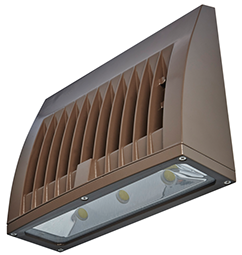Rosalind Franklin University
University's exterior LED luminaires offer dramatic results
Founded in 1912 as The Chicago HospitalCollege of Medicine and renamed Rosalind Franklin University of Medicine and Science (RFUMS) in 2004, the North Chicago-based university offers students an exceptional clinical education, research opportunities and exposure to emerging technologies. It has more than 2,000 students in five schools.
Sustainability
RFUMS is dedicated to establishing a University-wide plan that promotes environmental sustainability. The school’s Campus Sustainability Committee, which includes faculty, staff, students and architectural resources, is responsible for developing policies and guidelines for protecting natural resources, reducing the university’s ecological footprint and ensuring accountability for green building and low impact development.
While there are many components to RFUMS’ sustainability program, one of the goals is to reduce energy consumption on campus as a way to reduce energy costs while helping the environment. Facilities and Services has been working on energy lower reduction through numerous sustainable tactics, one being retrofitting outdated lighting fixtures with energy efficient LED luminaires.
Lighting Upgrade
Recently, Robert Jackson, director Facilities Management at RFUMS, oversaw the one-for-one retrofit of (119) 400W metal halide pole-mount fixtures to 240W LED luminaires in the school’s main parking lots. The impetus for this upgrade was improving security, and reducing energy and maintenance costs. Prior to this, the rental of a bucket truck and a maintenance team to replace incumbent fixtures was a time-consuming and expensive challenge, costing the University approximately
$8,000 annually. And although students and faculty would complain about burnt-out lights, Jackson didn’t have the resources to quickly fix them.
In addition to the main parking lots, new LED luminaires were installed at the school’s medical clinic’s driveway, just down the street from the main campus, the clinic’s parking lot, and wall packs on the building. RFUMS’ three student housing facilities also have been installed with exterior LED wall packs.
The new luminaires dramatically improve lighting performance and virtually eliminate maintenance. The time and money saved on re-lamping and the reduced energy costs can now be redirected to other campus needs. LED luminaires are designed to provide a virtually maintenance-free operation for more than 15 years in the harshest outdoor environments.
This LED installation is reducing the school’s energy costs by approximately 50 percent from the previous metal halide fixtures and with only a 2.5 year payback.
“RFUMS is committed to implementing new technologies that help us improve security, reduce energy use and lessen maintenance costs,” said Jackson. “These LED luminaires absolutely provide the level of light we were looking for to make the different areas bright and secure,” Jackson added.
The new installations improve visibility and safety for students and faculty, and the security cameras’ surveillance capabilities are greatly increased due to better illumination.
The LED lighting solution provides RFUMS with a highly efficient exterior lighting system that works toward its long-term sustainability goals. Additionally, the luminaires provide more uniform, targeted illumination that improves nighttime visibility for students and faculty. The lights are also incorporated into an adaptive campus-wide building control system. The system offers an intelligent, networked approach to lighting and energy management, with improved lighting quality and optimal energy efficiency.
Future Improvements
Jackson anticipates retrofitting the school’s three loading docks with 40W canopy recessed LED luminaires. A commitment to reducing energy consumption and environmental stewardship will help facilitate additional sustainable projects as funds become available.



